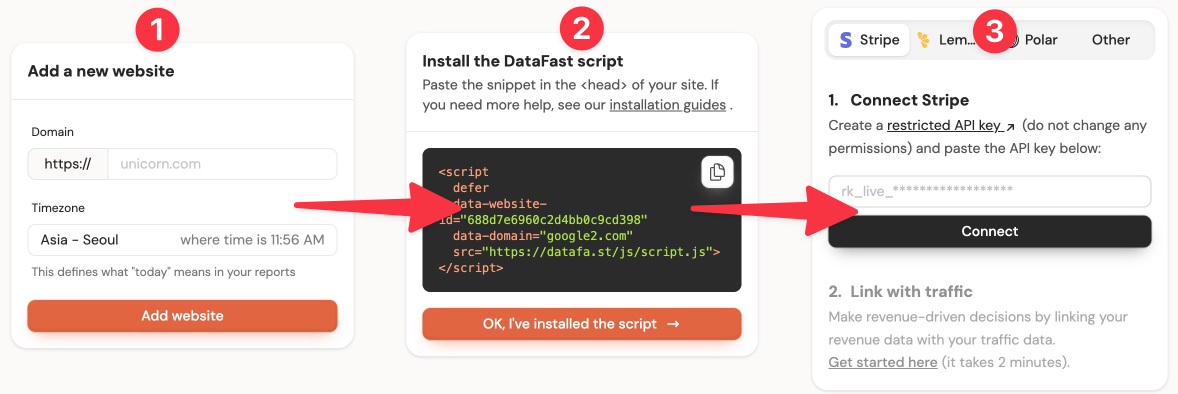- Just Ship It
- Posts
- Onboarding is killing your SaaS
Onboarding is killing your SaaS
You don’t need more users. You need to fix the leak in the funnel.

My little SaaS, DataFast, is now growing 4x faster than a year ago.
In my quest to improve MRR, I noticed something: 95% of people who signed up never became customers, ouch.
So I spent weeks maniacally polishing the onboarding flow.
DataFast's average revenue per visitor grew from $0.04 at launch to $0.30 in the last 30 days. Here are 4 lessons I’ve learned.
1. Show the promise first
The biggest win came from stripping the onboarding down to one goal: Get users to the “aha” moment as fast as possible.
For DataFast, that moment is the little orange revenue bar next to the traffic bar. It shows users exactly where their money is coming from.

So I redesigned everything around getting them to that chart. First, I put all features into 2 buckets:
Core Flow: Features that are required to reach the aha moment (install the tracking script, integrate with a payment provider)
Side Quests: They can help, but they don’t deliver the core promise upfront (invite team members, track custom goals)
Then I removed every feature that doesn’t fall into the Core Flow bucket. New users who sign up experience the following flow:

1 page = 1 step. Everything else is invisible. Complexity kills momentum. Treat attention like a limited resource.
Some of my users don’t want to integrate with payment providers yet, so I made this onboarding step skippable and added a popup to the main analytics dashboard.

All paths should lead to the aha moment.
2. Turn questions into documentation
On May 26th, 2025, I added a customer chat plugin and noticed users reach out whenever they’re stuck on the onboarding. This is gold.
Every time someone asked a question, I wrote a guide. Then I linked it inside the product, right where people usually get stuck.
Some of those guides now rank on Google, and AI assistants surface them too.

Users can self-debug themselves, and onboarding-related requests have dropped dramatically.
I polish the documentation as much as I polish the product. I deeply care about the UI/UX and make it very easy for my users to find what they need.

Your support inbox is the best roadmap for your docs.
3. Show the finished product early
Some parts of onboarding can’t be sped up. For DataFast, it takes time to collect enough data to show revenue insights.
So I made a video.

As soon as a user finishes the onboarding, they see a 60-second clip of a real DataFast dashboard — with revenue mapped to real traffic. It shows them what’s coming and gives them a reason to come back.
4. Test onboarding like a first-time user
Every time I update the onboarding, I opened an incognito tab and signed up again. I did the whole flow from scratch — no assumptions.
If anything confused me, I rewrote it. If any step felt unnecessary, I cut it.
Eventually, I saw tweets saying “DataFast’s onboarding is smooth.” That’s when I knew it was working.

You’re not done until even your grandma could do it.
Your best growth channel might be right under your nose: The people who already signed up — but never made it past step one.
Let them see the juice, fast.
— Marc Lou
3 startups I built to help you:
PS #1. I used to polish onboarding too early. Don’t optimize for retention until you have signs of demand (your guts will tell you).
PS #2. If you signed up for DataFast, but didn’t subscribe—why?
Reply